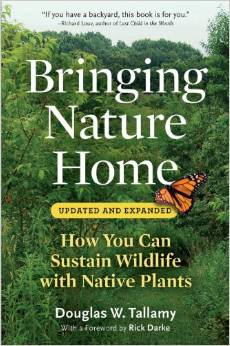 By turning natural habitats into shopping centers and housing developments we are taking away the food and places our wildlife need and thus bring about the disappearance of many of animals we enjoy and need. As author, Douglas Tallamy, notes in his book, Bringing Nature Home, we are trading our wild land for uncontrolled expansion so that in many parts of our country there is no place for wildlife except in the suburban landscapes and gardens we create. By restoring native plants in these suburban settings, where wildlife will increasingly live, we can move towards solving the problem and ensure future biodiversity in our country.
By turning natural habitats into shopping centers and housing developments we are taking away the food and places our wildlife need and thus bring about the disappearance of many of animals we enjoy and need. As author, Douglas Tallamy, notes in his book, Bringing Nature Home, we are trading our wild land for uncontrolled expansion so that in many parts of our country there is no place for wildlife except in the suburban landscapes and gardens we create. By restoring native plants in these suburban settings, where wildlife will increasingly live, we can move towards solving the problem and ensure future biodiversity in our country.
Tallamy develops his arguments for using native plants in the landscape through fourteen chapters covering many different aspects of the issue. He begins by discussing the role of suburban gardens in wildlife management and points out that the transition from alien ornamentals to native species will require “a profound change in our perception of the landscaping value of native ornamentals.” He continues with a discussion on the new role of the suburban garden and describes the problems created for wildlife by establishing lawns, paving roads, and building structures in the paths of birds. In the chapter on biodiversity he turns conventional wisdom around and poses the questions “What good are humans, and what purpose do they serve?” Interesting point of view! Later chapters discuss why insects can’t eat alien plants, the definition of “native” in regard to plants, the problems associated with using alien plants in the garden, the creation of ecologically balanced communities, and gardening for insect diversity. Rejecting the view that landscaping with natives in inherently less beautiful than using natives, Tallamy discusses the issue of dealing with neighbors that object to the new style of gardening and makes suggestions for changing a conventional garden to one filled with native plants. He provides lists and descriptions of plants he thinks are most beneficial and descriptions of benign insects a gardener can expect to find as native plants lure them into the garden. A final chapter is comprised of common questions (with answers) the author has faced when talking to gardeners about the use of native plants to sustain biodiversity.
Douglas Tallamy makes a compelling argument for changing the way we landscape in suburbia. In simple language and a down to earth voice, his book reveals the intricate interrelations between animals and plants and their importance to us. Biodiversity becomes a more personal goal as the means for achieving and maintaining it are presented. If you are concerned about the environment, nature, and wildlife of all kinds, Bring Nature Home is a must read.